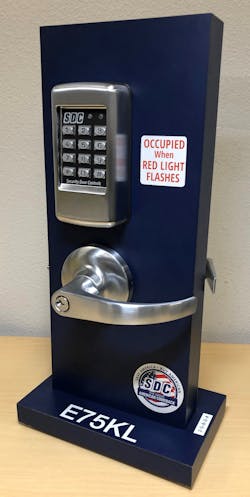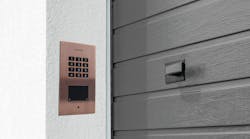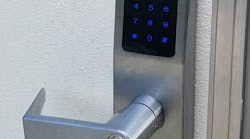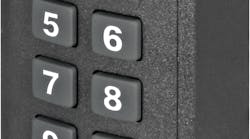Among the many possible applications that can involve a retrofit from mechanical hardware to electrified, one that’s drawn more attention from manufacturers in the past year is single-user public restrooms. A few companies market their stand-alone electronic door locks as such a possible application, with two — SDC and Alarm Lock — specifically aiming at public restrooms.
It’s reasonable to assume that there will be more of this. Code expert Lori Greene of Allegion reports on her website, idighardware.com, that the 2021 version of the International Business Code mandates the use of a visual indicator that denotes when a single-user public restroom is occupied. The new rule would apply to family or assisted-use restrooms.
Changes to life-safety codes aren’t applied immediately or across the board, so it might be some time before the new requirement filters through all communities. However, the new IBC mandate might be just the starting point.
International Plumbing Code, Greene reports, wanted to go beyond the IBC rule and mandate indicators on all single-user public restrooms, saying it was necessary to allay safety and privacy concerns. The proposal failed, but it certainly is possible that it could be pursued in the next revision.
The purpose of the indicator, of course, is to allow others to see that a restroom is occupied without a person having to knock or test the door handle or knob. As IPC notes, this could cause discomfort or even fear in certain cases. Plus, if the latch hasn’t been secured properly, it could result in the opening of a door.
Indication of Use
Several manufacturers make mechanical door locks that have so-called privacy indicators, with words such as “in use” or “locked” in red and “vacant” or “open” in green. In 2020, ASSA ABLOY brands SARGENT, Corbin Russwin and Yale introduced privacy indicators that can be used with certain mortise locks, including electrified options.
Alarm Lock and SDC have taken it a step further, building indicators into stand-alone battery-powered push-button locksets. Alarm Lock’s solution is part of its venerable Trilogy line. SDC’s version, the E75 Privacy Series, came out in 2020.
The E75 Privacy Series came about as the result of a good idea and a bit of good fortune. Hunter VanHulzen, factory sales manager at SDC, says the lock’s first prototype came about after the company CEO’s daughter wanted to turn the restroom in her private office into a lockout room. That led to a lock that had a button on the interior side of the door that locked out the exterior side’s keypad, so it wouldn’t operate.
“It happens, invariably, as you start doing things, that the market comes to you,” adds Kerby Lecka, SDC’s director of marketing. While SDC was putting together the prototype, the company got a request that pertained to restrooms at Starbucks stores seeking a similar type of product. “We went, ‘oh, now we have to make this real.’”
Alarm Lock’s and SDC’s restroom locksets have many similarities. Both are Grade 1 cylindrical locksets and allow for small-format interchangeable cores. They have keypad programming capability and entry, and versions of the series allow for prox card entry as well.
They also have red and green indicator lights on the exterior side and a lockout button on the interior. When a person enters the restroom and presses the button, it not only indicates that the restroom is occupied, but it also locks out the exterior keypad until the person exits the restroom or after a set length of time.
For SDC, the lockout duration can be set in 15-minute increments up to 60 minutes. When the time is up, the privacy function can be set to disengage or alert someone that an occupant has exceeded their allotted time.
With the latter option, “you’re notifying management that someone’s been in here for X amount of time. It’s time to go check on them,” VanHulzen says. “Through an [optional] auxiliary relay, we can have indication lights that will act like a bell or a chime, saying, ‘hey, go check on the bathroom. Someone might be in trouble.’”
Making the Switch
The dual capabilities — a lockout timer and the optional alert — are features that mechanical solutions can’t provide, Lecka says. That’s in addition to the usual electronic benefits of keyless entry, key control and, in the case of Alarm Lock, audit trail capability.
The best part for the locksmith is that the locks are battery-powered (four AA batteries for SDC, five for Alarm Lock), which means no pulling of wires is required to install these. That doesn’t necessarily mean no wiring is involved, however.
The Alarm Lock unit is self-contained, whereas the keypad is separate from the lock on the SDC unit, which necessitates the connection of a wire lead from the keypad to the cylindrical lock.
“We say, ‘you have to connect some wires,’” VanHulzen notes. “It’s not like you need to know any low voltage or anything like that. It’s pretty self-explanatory.”
The locks can be retrofit on a standard cylindrical door prep, although, because it’s a two-piece unit, the SDC model might require some drilling and boring for a second hole if the existing prep doesn’t include a deadbolt. If it does, the keypad can fit into the deadbolt hole. Then you’d have to drill to the lock for the connector wire.
“It’s a pretty easy install,” VanHulzen says. “I’ve actually installed a couple of these myself on a few different doors, and I’d say it takes about 20 minutes.” He adds that although you don’t negate fire code on the door when you retrofit the lock, you would have to relabel the door in such a case to remain in code compliance.
Alarm Lock’s and SDC’s restroom locks are aimed at indoor or outdoor use, and SDC notes that the lockset has a built-in-clutch, which allows the lever to turn without retracting the latch when locked. This helps to make it resistant to vandalism.
Although the lock was aimed at single-user public restrooms, Lecka says SDC’s E75 Privacy Series also would be a simple mechanical to electronic upgrade for meeting rooms in corporate offices, study rooms at college campuses or even counseling rooms where people would want to work without being disturbed.
“If you think about it, it has more applications than just bathrooms,” he says.






